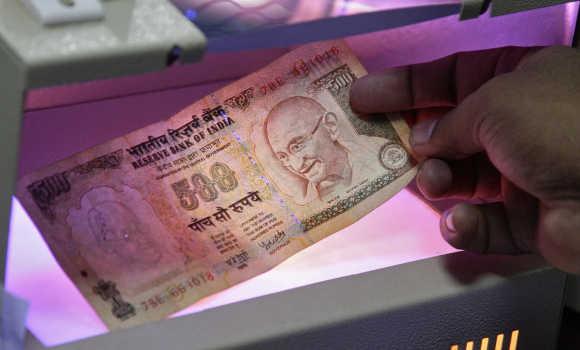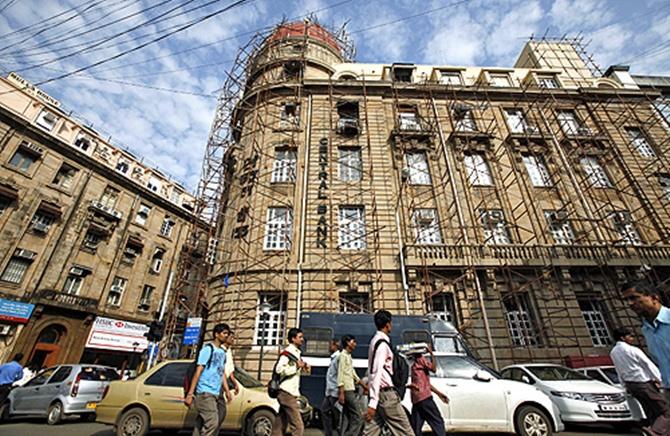Photographs: Manjulkumar/Wikimedia Commons Janmejaya Sinha
Public sector banks face two key challenges - manpower and capital. Sadly, these are not on the agenda for reform, says Janmejaya Sinha.
There is much discussion today on providing foreign banks near national treatment but unfortunately no interest in providing our public sector banks (PSBs) the same.
The favourite whipping boys in India – of the government, the Reserve Bank of India (RBI), the media, competitor banks, rating agencies, random intellectuals and even some industrialists – the PSBs, are in dire need of immediate attention and reform.
For over two decades, Indian banking has operated under three disparate regulatory policy regimes creating three different industries in India — the PSB industry, the private bank industry and the foreign bank industry.
Foreign banks have complete freedom in terms of incentives and compensation, some forbearance in respect of priority sector lending, but have strict controls in obtaining branch licences.
PSBs offer job security but very poor compensation and incentives, constraints in their ability to raise capital (due to the need to maintain the government stake at 51 per cent), but have freedom in opening branches.
...
How India can reform its public sector banks
Photographs: Reuters
They have, in addition, the onerous compulsions of complying with the oversight of India’s vigilance apparatus – the Central Vigilance Commission, the Comptroller and Auditor General, the Central Bureau of Investigation – and constraints in self-directed acquisitions on account of the Bank Nationalisation Act.
Private sector banks have operated somewhere in between these two ends. Till recently they had significant constraints on chief executive officer (CEO) and senior executive salaries and incentives (that have been relaxed recently but are still below foreign banks), have more latitude than public sector banks in terms of acquisitions and similar freedom in respect to branch opening.
These regulatory and ownership compulsions and have led to clear and differentiated business model choices for the different kinds of banks in India.
...
How India can reform its public sector banks
Photographs: Reuters
The PSBs have done the bulk of the balance sheet business; in fact, 75 per cent of all lending sits on PSB books. They also have a strong retail liability franchise.
The foreign banks business has consisted mostly of capital advisory, structured products, foreign exchange, trade and priority banking for affluent customers. Foreign banks corner over 95 per cent of the market profits from foreign exchange and structured products and use less capital, while the bigger ones generate very high returns. Private banks operate in between these ends.
At another time I will take on the misdirected statements and criticism coming out of the government and RBI on the growing non-performing assets within the PSBs.
Suffice it to say that 64 per cent of restructured assets of the industry are in the core sectors of – steel, power, telecom, infrastructure and textiles – on account of policy infirmity.
Yet PSBs have made great strides in their operating efficiency over the past decade. They have improved their key operating ratios in a meaningful way.
...
How India can reform its public sector banks
Photographs: Reuters
They have increased return on assets (RoA) from a 0.5 per cent to 0.8 per cent, debt equity from 17 per cent to 12 per cent, and cost-to-income ratio from 63 per cent down to 45 per cent.
The old images of overstaffing are completely untrue. In 2000, PSBs had total assets of Rs 9,23,631 crore with 874,116 employees. Today they have total assets of Rs 69,61,967 crore with 811,333 employees.
They are all listed, on core banking, often offer equivalent levels of service and are the preferred suppliers to certain customer segments.
Yet they face two key challenges - manpower and capital. If these are not addressed they will destruct. However, this is not on the agenda for reform. The very rapid branch expansion in the 1970s and 80s, with the accompanying heady recruitment of personnel, led to great overstaffing in PSBs in the 1980s.
...
How India can reform its public sector banks
Photographs: Reuters
In response, Rajiv Gandhi imposed an employment freeze between 1985 and 1991. Before 1985, PSBs used to attract high-quality talent — there were no other jobs. After 2000, their employment offer is just not attractive.
New hires that join PSBs are of much poorer quality, and the better ones tend to leave early — overall attrition rate for PSBs is 5 per cent a year but it is 12 per cent for fresh recruits.
Many of the pre-1985 hires are starting to retire and the inability to hire new quality talent is making the manpower situation more precarious every day.
Four changes are required immediately.
- The need to increase the retirement age to 63, so that they could get three more years from the pre-1985 hires.
- Make all chairman & managing director and executive director appointments for a minimum of three years, as is the practice in RBI and the State Bank of India now.
- Set the salary of PSB chiefs at 60 per cent of the average salary of the CEOs of the three largest private sector banks in India.
- Encourage and facilitate lateral recruitment into PSBs after correcting the salary, not the other way round.
The second binding constraint is in their inability to raise capital. As a rule of thumb, a bank can grow at about 13.5 per cent with a 1 per cent RoA without raising additional capital.
...
How India can reform its public sector banks
Image: Headquarters of Central Bank of India in Mumbai.Photographs: Danish Siddiqui/Reuters
The Indian banking industry has been growing on average at about 18 per cent a year. This means that PSBs need to raise capital often even to grow at the market. The 51-per cent government holding stipulation adversely affects their ability to compete.
There are different choices that the government can explore – preferential shares, golden shares, and differential voting rights – to retain control at lower levels of holding. In fact, RBI guidelines for new bank licences, that stipulate the bank promoter cannot own more than 15 per cent stake in the bank after 12 years, and no single investor can hold more than 5 per cent, should be imposed on government-promoted banks.
The reduction below 51 per cent will also take these banks out of the vigilance apparatus that will greatly enhance the speed of their decision-making.
There are two further constraints that inhibit them. Under the Bank Nationalisation Act, they can only make acquisitions through an Act in Parliament. If they were corporatised, like, say, IDBI Bank, they would have freedom in respect of acquisitions without any dilution in government control.
...
How India can reform its public sector banks
Image: SBI, MumbaiPhotographs: Manjul Kumar/Wikimedia Commons
Finally, there is an urgent need to improve the quality of their board of directors. It would be useful to create a government-approved panel of directors from which PSB nomination committees could pick their directors. The RBI also needs to improve the remuneration payable to bank directors in the industry if it would like banks to attract talent.
The current structure of Indian banking has within it some very valuable features. Government promoted, listed, efficient banks, competing with innovative private players, allaying depositor risk concerns, not retreating in times of crisis, and serving a larger national purpose.
China grew rapidly for close to three decades with less efficient but better paid managers in their PSBs. We could have a stronger banking sector if we saw it as a critical utility that needed to be efficient, stable and responsive to the needs of India’s development.
But for this, we must address the manpower and capital constraints PSBs face today. We don’t need to privatise PSBs for this, only have a readiness to allow them near national treatment. Sadly, reform looks unlikely.
The author is Chairman, Asia Pacific, BCG. These views are personal.









article